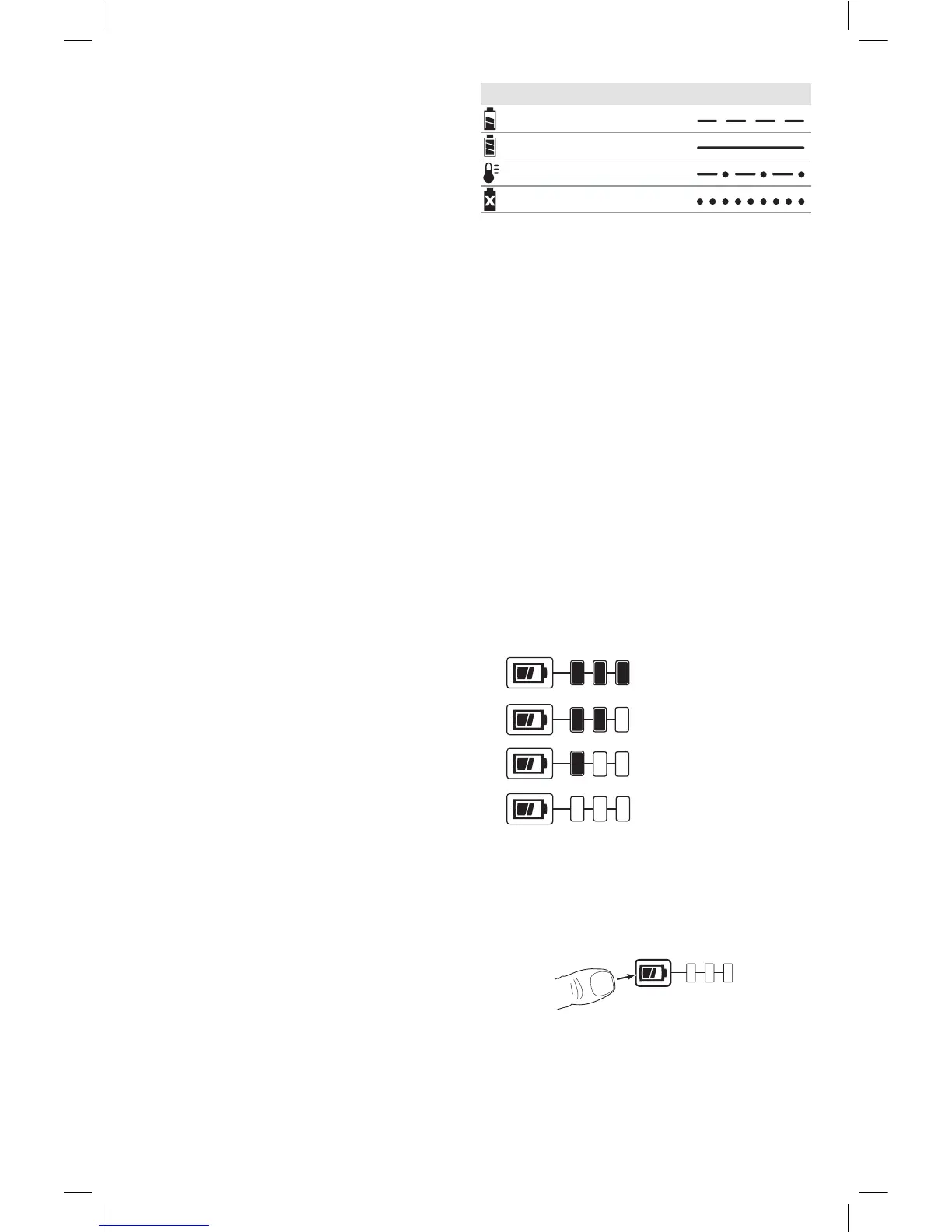ENGLISH
6
(+4.5°C), or above +104°F (+40°C). This is important
and will prevent serious damage to the battery pack.
2. The charger and battery pack may become warm to the
touch while charging. This is a normal condition, and
does not indicate a problem. To facilitate the cooling of
the battery pack after use, avoid placing the charger or
battery pack in a warm environment such as in a metal
shed or an uninsulated trailer.
3. If the battery pack does not charge properly:
a. Check operation of receptacle by plugging in a lamp
or other appliance;
b. Check to see if receptacle is connected to a light
switch which turns power off when you turn out
thelights;
c. Move the charger and battery pack to a location
where the surrounding air temperature is
approximately 65°F – 75°F (18° – 24°C);
d. If charging problems persist, take the tool, battery
pack and charger to your local service center.
4. The battery pack should be recharged when it fails to
produce sufficient power on jobs which were easily
done previously. DO NOT CONTINUE to use under these
conditions. Follow the charging procedure. You may
also charge a partially used pack whenever you desire
with no adverse effect on the battery pack.
5. Foreign materials of a conductive nature such as, but
not limited to, grinding dust, metal chips, steel wool,
aluminum foil, or any buildup of metallic particles
should be kept away from charger cavities. Always
unplug the charger from the power supply when there
is no battery pack in the cavity. Unplug the charger
before attempting to clean.
6. Do not freeze or immerse the charger in water or any
other liquid.
Charging a Battery
DO NOT attempt to charge the battery pack with any
chargers other than those specified by the manufacturer.
1. Plug the charger into an appropriate outlet before
inserting battery pack.
2. Insert the battery pack into the charger, making sure
the battery pack is fully seated in the charger. The
charging light will blink continuously indicating that the
charging process has started.
3. The completion of charge will be indicated by the light
remaining ON continuously. The battery pack is fully
charged and may be used at this time or left in the
charger.
NOTE: To ensure maximum performance and life of lithium-
ion battery packs:
- Charge the battery pack fully before firstuse.
- Recharge discharged batteries as soon a possible
after every use.
- Do not discharge batteries fully.
Charger Diagnostics
Refer to the indicators below for the charge status of the
battery pack.
Indicators
Charging
Fully Charged
Hot/Cold Pack Delay
Bad Battery
Bad Battery
If you see a bad battery blink pattern, do not continue
to charge this battery. Return it to a service center or a
collection site for recycling.
Hot/Cold Pack Delay
When the charger detects a battery pack that is too hot
or too cold, it automatically starts a Hot/Cold Pack Delay,
suspending charging until the battery pack has reached an
appropriate temperature. The charger then automatically
switches to the pack charging mode. This feature ensures
maximum battery pack life.
A cold battery pack will charge at a slower rate than a warm
battery pack. The battery pack will charge at that slower rate
throughout the entire charging cycle and will not return to
maximum charge rate even if the battery pack warms.
State of Charge indicator (Fig. B)
Some
battery packs include a fuel gauge which
consists of three LED lights that indicate the level of charge
remaining in the batterypack.
The fuel gauge is an indication of approximate levels of
charge remaining in the battery pack according to the
followingindicators:
75–100% charged
51–74% charged
< 50% charged
Pack needs to be charged
To actuate the fuel gauge, press and hold the fuel gauge
button. A combination of the three green LED lights will
illuminate designating the level of charge left. When the
level of charge in the battery is below the usable limit, the
fuel gauge will not illuminate and the battery will need to
berecharged.
Fig. B
NOTE: The fuel gauge is only an indication of the charge
left on the battery pack. It does not indicate appliance
functionality and is subject to variation based on product
components, temperature and end-userapplication.
For more information regarding fuel gauge battery packs,
please contact call 1-800-4-

